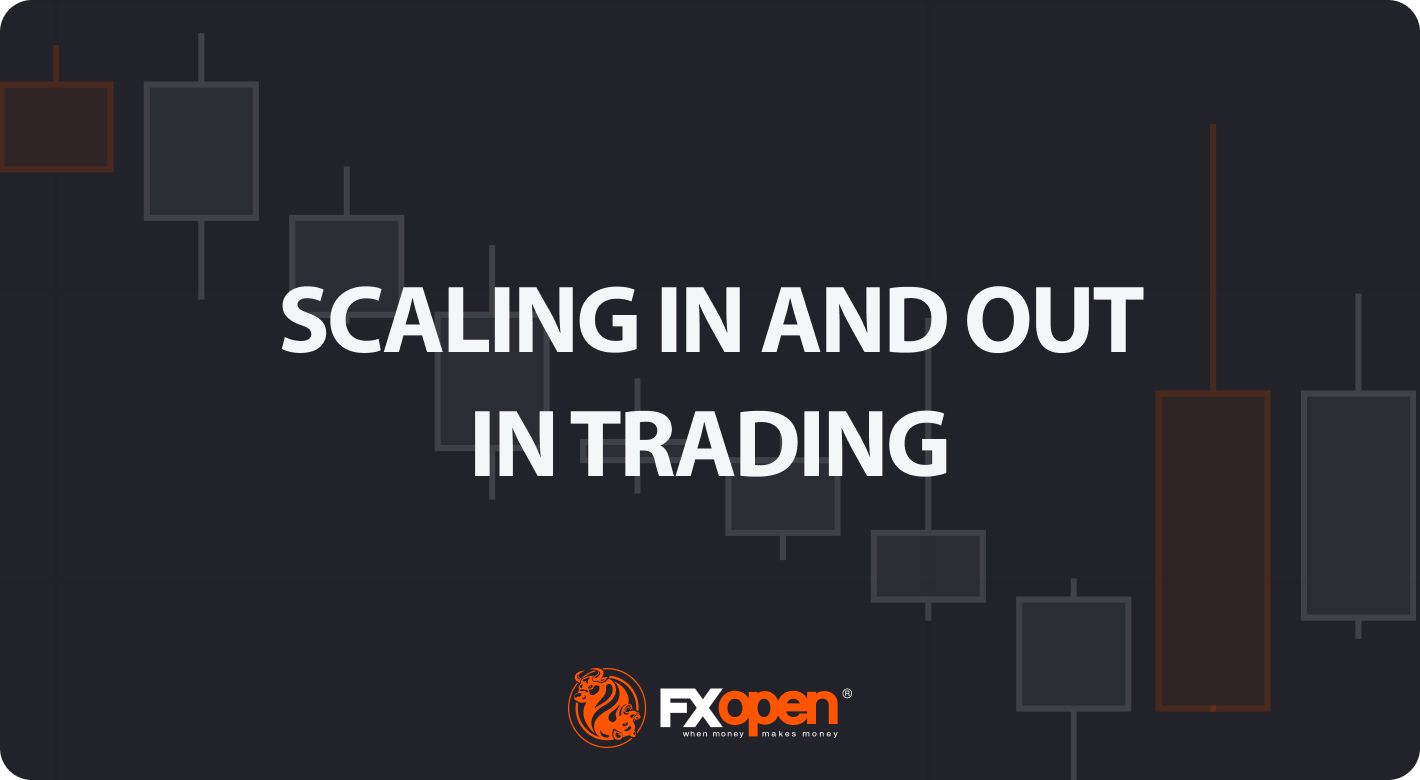FXOpen

One strategy that helps traders manage the complex endeavour of targeting high profits and mitigating risks is scaling in and out of trading positions. This approach, when executed correctly, can be a valuable tool in a trader’s daily activities. In this article, we will delve into the trading style referred to as scaling in and out, exploring what it means, how to do it effectively, and what common pitfalls to avoid.
Understanding Scaling in Trading
Basically, the scale in/scale out trading strategy means adding/removing units from your originally opened position. This approach provides several advantages, primarily risk management, profit optimisation, and flexibility.
Scaling in is the process of entering a trade in multiple increments rather than going all in at once. It allows traders to start small, which can be particularly useful in highly volatile markets. By entering a position in increments, you can test the waters without committing your full capital. This measured approach can help limit potential losses if the trade goes against you.
Scaling out, on the other hand, involves partially closing a position in multiple increments. The key here is to lock in profits while allowing a portion of your position to ride the market's trend. While scaling out can reduce initial risk, it also carries its own set of challenges. Traders must be cautious not to become too conservative, missing out on potential profits.
The Synergy of Scaling In and Out of Trades
When scaling into positions while trading any asset, you will first need to identify entry points for the initial position, as well as target prices for that asset. This is often based on technical indicators, chart patterns and/or candlestick formations. The true power of scaling strategies becomes apparent when you combine scaling in and out in your trading, enabling you to fine-tune your risk and reward profile and making your trading more adaptable.
Scaling in involves acquiring assets as their prices rise or selling when the price declines. You can establish a predefined target price and initiate buying or selling orders in incremental volumes whenever the asset's value climbs above or falls below this threshold. This process of buying or selling continues until all predefined targets are reached or the desired trade size is achieved.
Scaling out trading is about exiting positions partially once your targets are reached, but the price continues to move in the same direction. You can start closing trades partially, still keeping the trade open and allowing yourself to capitalise on trend continuation.
Scale Trading with Retracement Levels
Effective scaling requires the application of a well-thought-out approach for traders focused on any time frame. We present an idea of how to scale in or out of a trade. Scaling in and out with retracement levels can be implemented as described below.
Scaling In
Let's say a trader identifies a strong uptrend in a currency pair, such as EUR/USD. They notice that after significant upward movements, the price often retraces to key Fibonacci retracement levels, like the 38.2% or 50% level, before continuing the uptrend. In this scenario, the trader scales in by entering a smaller position at the initial stage of the uptrend. As the price retraces to a Fibonacci level or breaks above it, they add to their position, taking advantage of the expected bounce from the retracement level. This allows them to maximise their position while managing risk, with a stop-loss set below the retracement level.
Scaling Out
Suppose a trader has been in a long position during an uptrend and has set profit targets based on Fibonacci retracement levels. As the price reaches the 61.8% retracement level, the trader decides to start scaling out by selling a small portion of their position. This can be a prudent move as the price often encounters resistance at this level. If the uptrend continues and surpasses the 61.8% level, the trader can continue scaling out at significant Fibonacci extension levels, such as 78.6% or 100%. Following this strategy, the trader could secure profits at key retracement levels while letting a portion of their position run in anticipation of further gains.
Interested in trying out scaling into positions trading? You can head over to FXOpen's free trading platform TickTrader, and extend your trading experience.
Scaling in Forex Trading: Common Pitfalls
Scaling into forex trades can be a viable strategy, but it has its pitfalls that can lead to cascading losses and margin calls.
- Over-Leveraging: Traders who scale in with excessive leverage can quickly find themselves in a margin call situation, risking substantial losses.
- Neglecting Risk Management: Some traders may become too focused on increasing their position size and neglect setting stop-loss orders or defining their risk tolerance.
- Ignoring Currency Correlations: Scaling in on both EUR/USD and GBP/USD simultaneously, for example, may unintentionally increase your risk exposure since these pairs often move in a similar direction.
- Revenge Trading or Chasing Losses: Traders who suffer losses on their initial position may scale in with the hope of recovering quickly, often disregarding their trading plan and analysis.
- Inadequate Analysis: Entering positions without a solid rationale can lead to haphazard trading and inconsistent results.
- Scaling Into a Trend Reversal: Traders may be tempted to scale in positions while a trend is reversing, hoping for a quick turnaround. This can result in further losses, as it is essential to distinguish between pullbacks and trend reversals.
Conclusion
In conclusion, scaling in and out in trading can help manage risk and increase profits. Whether you are trading stocks, cryptocurrencies*, or forex, the principles of scaling can be adapted to suit your preferences and risk tolerance. The key is to understand the nuances of scaling, employ the right tools and techniques, and establish clear criteria for making scaling decisions. Ready to explore new trading opportunities? You can open an FXOpen account and discover new possibilities.
*At FXOpen UK and FXOpen AU, Cryptocurrency CFDs are only available for trading by those clients categorised as Professional clients under FCA Rules and Professional clients under ASIC Rules, respectively. They are not available for trading by Retail clients.
This article represents the opinion of the Companies operating under the FXOpen brand only. It is not to be construed as an offer, solicitation, or recommendation with respect to products and services provided by the Companies operating under the FXOpen brand, nor is it to be considered financial advice.
Stay ahead of the market!
Subscribe now to our mailing list and receive the latest market news and insights delivered directly to your inbox.








